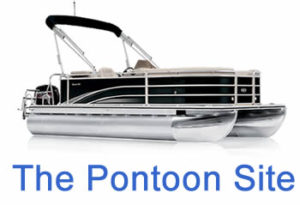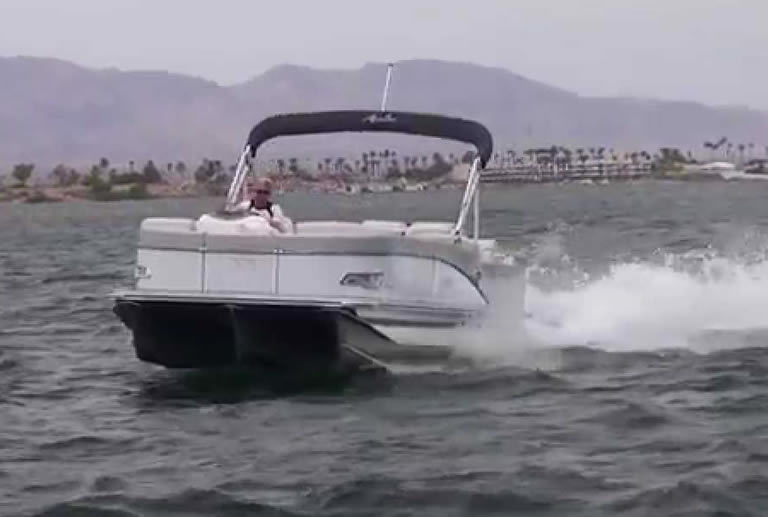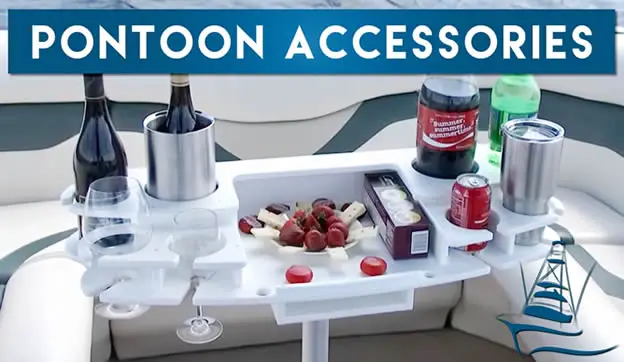Pontoon boats are seen as a great choice for all-round recreational boating especially on calm inland waters. They are stable and safe while being easy to handle and maintain. They also make a good choice for fishing as well as cruising, entertaining and enjoying group trips.
But what happens if you and your pontoon end up in rough water?
Contents
- Pontoon boat safety in rough water
- Optimal water conditions for pontoon boats
- Why are you in rough water on a pontoon boat?
- The challenges rough water offers pontoon boats
- What’s the worst that can happen?
- Staying safe in rough water: key tips and steps for pontooners
- Helpful adaptations and upgrades for rough water pontooning
- Tritoon vs pontoon
- In conclusion
Pontoon boat safety in rough water
Are pontoon boats safe in rough water?
Pontoon boats are not safe to use in rough water. Higher-end vessel can handle small chop but a pontoon boat can easily submarine and sink in rough water.
Although the higher-end pontoon & tritoon boats can handle a certain amount of chop these vessels are not designed for challenging weather or challenging water conditions.
Optimal water conditions for pontoon boats
Pontoon boats are designed to be used in calm waters. Their shallow draft means pontoon boats are excellent shallow water vessels.
Pontoon boats perform best in calm in-shore waterways and lakes. Likewise, this type of boat will perform well in protected off-shore or inter-coastal areas such as bays or coves where the sheltered conditions keep the sea calm.
These watercraft are stable and wide and, with appropriate use, you are unlikely to run into problems. However, there are notable exceptions.
Although pontoon boats are, for the most part, capable of being used in challenging weather conditions and choppy waters there are risks involved when you are handling your pontoon boat in rough water. So it is important that you know how to keep yourself and your passengers safe.
Why are you in rough water on a pontoon boat?
You can end up in rough water in a pontoon for a number of reasons.
Clearly venturing out on the water while ignoring adverse weather reports or warnings is ill-advised. But even following weather warnings may not be enough to prevent a rough water experience.
A pontoon boat skipper might find himself or herself in unexpected bad weather and thus have to execute maneuvers to get their passengers safely to shore quickly.
So, if you find yourself in deteriorating weather conditions on a pontoon boat you need to know how to act quickly and safely to get your boat out of the potential danger area.
Wash from larger vessels in a busy waterway can also pose challenges for pontoon boats, so it is always important to remain vigilant in regards to others on the water.
Although pontoon boats are capable of being used in the sea these vessels are not truly seaworthy (with some notable exceptions, such as catamarans).
For this reason it is much more common to see a pontoon boat on a lake or similar inland waterway where the conditions are calm.
That being said, conditions on even the most still waters can change rapidly, especially if you are in a wide river channel or on a very large body of water that has little protection from the wind. Open bodies of water such as lakes or lagoons can kick up large waves if hit by strong winds.
Rising wind speeds and red flags may be a signal that it’s time to head for home.
Experienced pontoon boaters know that if you see the signs of negative changes in conditions it is best to get off the water.
The challenges rough water offers pontoon boats
Rough water poses some significant challenges for pontoon boats due to their unique hull design. Most recreational boats have a flat-bottom hull designed for optimal stability that also offers a very smooth ride on calm waters.
Boats designed to handle rough water have a very different type of hull that feels more “tippy” but that is actually harder to tip. A V-hull boat, for example, will easily outperform a pontoon boat in choppy water as its hull can cut through the waves. Deep v-hull boats can handle just about any type of water the ocean can throw at them due to their deep draft.
Pontoon boats “sit” on the water and cannot cut through the waves. This means a pontoon boat can actually dive into large waves and thus take on water. A pontoon boat also has a shallow draft making it less stable in rough water than a deeper draft boat.
To understand the differences between hull types as well as shallow and deep draft read this article.
Executing turns in high winds can also cause pontoon vessels with cabins to capsize. When the bow dips, rough waves can even rip off the fittings on the boat, bend the pontoons and thoroughly wash the deck.
Water ingress can cause engine cavitation and short the electronics of the boat, making it even harder to get to shore.
In short, rough water can damage a pontoon boat.
Even when back at the dock the size and profile of a pontoon boat can make it difficult to trailer or to get tied down safely in challenging weather.
What’s the worst that can happen?
Many people who own pontoon boats, and who like to take them out on the water in less than desirable conditions, can often be flippant about the dangers. But, it is important to be clear that recreational boating accidents claim lives!
Pontoon boats had the 5th highest casualty rate for recreational boating accidents in 2017 and 2018 according to United State Coast Guard Statistics.
Bad weather conditions and inappropriate boating practices due to a flippant attitude to the dangers can mean you can flip a pontoon relatively easily and this is a sobering reality.
Even experienced mariners recount incidents where high winds caused loss of control of the pontoon that lead to the very real risk of tipping. Tipping a pontoon boat can lead to drowning in open water or can cause you or your passengers to be dragged into the water and crushed against the dock when close to shore.
Submarining a pontoon boat
Handling a pontoon boat on and off the water will also be a deciding factor, especially if it’s only for individual use, while small pontoon boats may be perfectly manageable, fully laden larger vessels may be dangerous to crew single handed, especially if you are inexperienced or new to the water.
A pontoon boat is considered a flat-bottomed boat because its hull has a relatively shallow draft which generally makes it unsuitable for less than favourable conditions. This hull design also has a propensity to ‘dive’ or ‘submarine’ when the nose of the pontoons becomes overwhelmed by large or even medium sized waves (see video below).
While sizeable waves from a choppy sea can breach the side walls of the pontoon boat, so too can the wake of a passing boat. If a pontoon boat is travelling at speed and is suddenly confronted with the swell created by a passing boat, the pontoon tubes can become jarred in the wake resulting in rapid deceleration.
Submarining a pontoon boat is highly dangerous and can cause injury to crew and passengers onboard. Although larger pontoon boats are less prone to tipping and sinking submarining can happen to any pontoon boat regardless how the large the vessel is.
Read our article on why did my pontoon boat nosedive for more information on keeping your boat afloat.
On that note, if your pontoon boat is to be used in the saltwater conditions of the sea, be advised to do so only in fair weather, keep to bays and coves and don’t stray too far from shore.
Read our article why do pontoon boat sinks for a deeper analysis of the causes of pontoon boat accidents and how to avoid them.
Staying safe in rough water: key tips and steps for pontooners
Although some manufacturers claim their pontoon boats are made to handle more than calm water it is clear from the evidence that rough water is best avoided when boating on a pontoon. However, sometimes avoiding bad weather is unavoidable.
Should you find yourself in a situation where the weather has turned nasty the following points outline how to handle your pontoon boat if you find yourself in choppy water.
Maintain awareness and communicate
Maintain oversight of what is happening onboard. Make sure you have the full attention of passengers as they will need to follow your instructions should the weather take a turn for the worse.
Be sure, from the outset, that everyone onboard your vessel is aware that should you give the signal everyone knows they must follow your lead without question.
Don’t be afraid to radio for assistance if you think you will need it. Even if you feel you don’t need assistance make sure others on shore know where you are and keep them updated regularly if you start to encounter difficulties.
Watch your load
In bad weather conditions, the way in which your pontoon is loaded is critical to ensure the boat remains stable.
Instruct passengers to distribute heavy items evenly across the deck and to also position themselves evenly to optimize weight distribution so that the boat does not tilt to one side or the other.
Placing heavier items at the rear of the boat and away from the front is also a good idea so that the bow stays up in rough waves. Trimming also helps with this.
Consider your trim
When hitting waves it is advisable to trim up prior to encountering the waves as the bow will be lifted more.
Lifting the bow up in this manner means your boat will be less likely to take on water from incoming waves hitting the front of your boat.
Watch the wind
Where is the wind coming from?
Be aware of the direction of the wind. Performing turns in high winds is risky, especially if you have a canopy, cabin or other raised structure erected on your boat.
As I already mentioned above, challenging conditions, caused by windy weather, can also make it very difficult to dock a pontoon.
Take on waves at an angle
Knowing how to drive a pontoon boat in challenging conditions is an essential safety skill you must develop.
Keeping your pontoons and nosecones above the water helps you to avoid taking on water. Do all that you can to keep the bow above water.
Experienced boaters advise taking on waves at an angle and trying to, as much as possible, ride waves rather than dip under them. Be aware that, although counterintuitive, slowing the vessel actually increases the chance that the bow will go under the wave.
Keep an eye on your fuel
You may think that keeping an eye on your fuel levels is something that should be done prior to venturing out onto the water. But, rough winds and challenging waters consume fuel!
If you see bad weather ahead ensure you have more than enough fuel to reach the dock. Don’t think that just because you have enough fuel to navigate the waters under normal conditions that you have enough for challenging conditions. Be prepared for your boat burning up fuel at a much higher rate.
Without wishing to instill a sense of fear into pontoon boat owners it is important to note that handling watercraft at anytime in adverse conditions is difficult for even the most experienced boaters. Handling pontoon boats is even harder.
Prevention is always better than cure, so you should always have a low threshold for tolerating bad weather.
If you see signs of poor weather head for the dock.
Always prioritize safety over a few extra minutes of fun.
Helpful adaptations and upgrades for rough water pontooning
As the design and engineering specs of modern pontoon boats have approached the same level of performance as modern day powerboats, manufacturers have striven to include additional adaptations to their boats so they can take advantage of these improvements. After all there is not point giving a pontoon boat the same type of power as a speedboat if the vessel is incapable of using that power safely.
Many modern pontoon boat adaptations, as well as some pontoon boat accessories, are largely designed to improve the ability of pontoons to handle higher speeds and to also handle rougher water.
Examples include:
- Barracuda nose cones
- Triple tube pontoons
- Lifting strakes
- Power-assisted steering
- Increased engine horsepower and fuel efficiency
Tritoon vs pontoon
Although you should never bring any type of flat bottom boat into rough challenging waters there is a type of pontoon boat that can handle that type of water better than a standard pontoon.
When it comes to rough waters a 3-tube tritoon boat can handle the chop a lot better than a 2-tube pontoon boat.
A pontoon boat is designed with a flat bottom hull that sits on two buoyant pontoon tubes. These tubes allow the boat to sit fairly high in the water and offer increased speed, stability and comfort on calm or shallow waters.
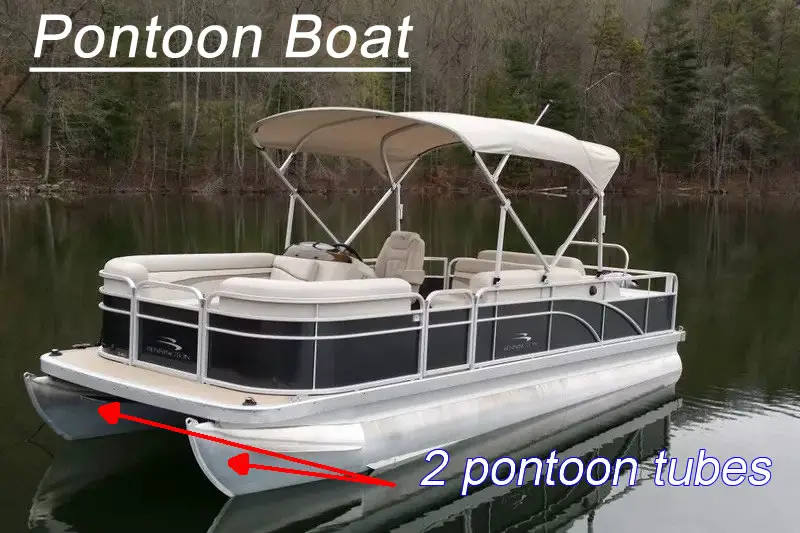
Where a pontoon boat has two pontoon tubes on the underside of the hull, (read about how the tubes are made and how they keep the boat afloat in this article), one at each side of the boat, a Tritoon has an additional pontoon tube on its underside in the middle of the hull.
That extra pontoon tube gives the boat a lot more stability in choppy waters.
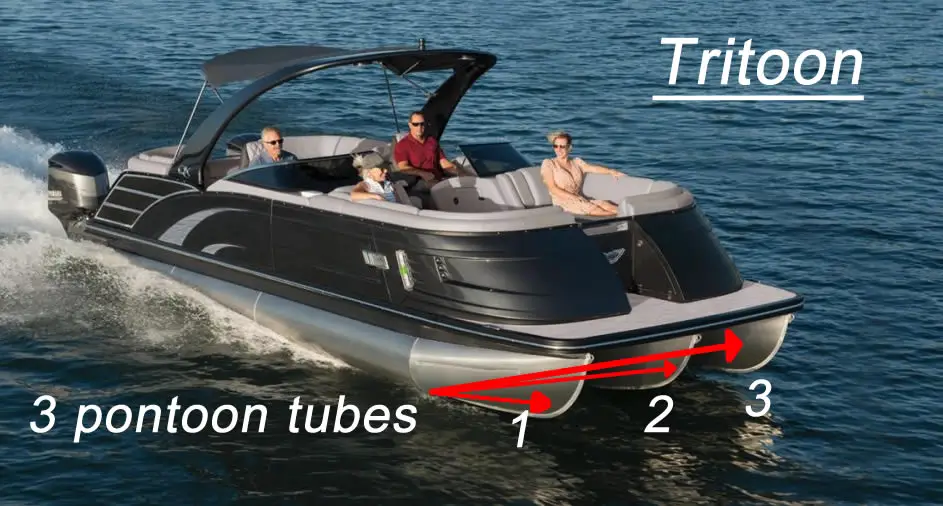
Although a tritoon can handle enough waters better than a normal pontoon boat this does not mean it was built for rough water use!
No flat bottom boat, even one that sits on buoyancy aids like pontoon tubes, is designed for rough water usage. So always try to avoid using any type of pontoon boat in very challenging weather or water conditions.
You read more about the tritoon here.
In conclusion
Though larger and heavier pontoon boats are better able to withstand poor weather conditions and choppy water, pontoon boats, in general, are not designed to withstand the rigors and challenges of rough water. Few recreational boats are.
To stay safe in a pontoon boat it is best to stay away from rough waters.
However safety is not the only reason to get your boat out of rough water. Bad weather takes its toll on a pontoon boat and an encounter with rough weather can end up damaging your boat. It i therefore advisable to keep exposure to these conditions to an absolute minimum to keep you and your boat safe.
However, using some common sense and following some simple rules can keep you safe and keep your boat from being damaged if you do encounter adverse weather conditions while pontooning.
Vigilance in regard to changing conditions on the water and getting to shore quickly is the first step, ensuring your passenger’s know what to do in the event of sudden and unexpected weather changes is the second. Finally executing considered maneuvers in the correct way may just get you out of a rough water scenario with your boat and your passengers intact.
